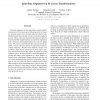Free Online Productivity Tools
i2Speak
i2Symbol
i2OCR
iTex2Img
iWeb2Print
iWeb2Shot
i2Type
iPdf2Split
iPdf2Merge
i2Bopomofo
i2Arabic
i2Style
i2Image
i2PDF
iLatex2Rtf
Sci2ools
CVPR
2008
IEEE
2008
IEEE
Joint data alignment up to (lossy) transformations
Joint data alignment is often regarded as a data simplification process. This idea is powerful and general, but raises two delicate issues. First, one must make sure that the useful information about the data is preserved by the alignment process. This is especially important when data are affected by non-invertible transformations, such as those originating from continuous domain deformations in a discrete image lattice. We propose a formulation that explicitly avoids this pitfall. Second, one must choose an appropriate measure of data complexity. We show that standard concepts such as entropy might not be optimal for the task, and we propose alternative measures that reflect the regularity of the codebook space. We also propose a novel and efficient algorithm that allows joint alignment of a large number of samples (tens of thousands of image patches), and does not rely on the assumption that pixels are independent. This is done for the case where the data is postulated to live in a...
Computer Vision | Continuous Domain Deformations | CVPR 2008 | Data Complexity | Data Simplification Process | Discrete Image Lattice | Joint Data Alignment |
| Added | 12 Oct 2009 |
| Updated | 12 Oct 2009 |
| Type | Conference |
| Year | 2008 |
| Where | CVPR |
| Authors | Andrea Vedaldi, Gregorio Guidi, Stefano Soatto |
Comments (0)

